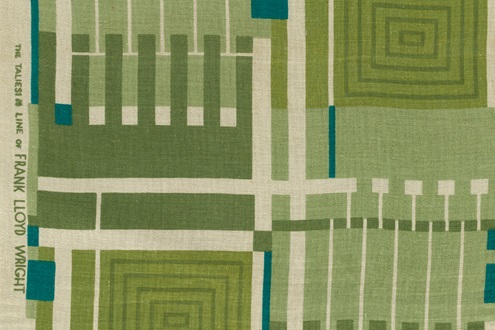The Met is peeling back the curtain to present object and textile designs by architect Frank Lloyd Wright (1867–1959) that were made for the first commercial venture of his long and eminent career. Wright created the affordable home products for the general consumer in 1955. The exhibition, "Frank Lloyd Wright Textiles: The Taliesin Line, 1955–60," opens at The Metropolitan Museum of Art on May 20, 2019 and features printed and woven textiles, wallpapers, and mahogany vases from the line, many recently acquired for The Met collection. The exhibition continues on view through April 5, 2020.
Wright's affordable designers were born at the urging of Elizabeth Gordan, the editor of House Beautiful magazine. Wright went on to design a line of fabrics and wallpapers for F. Schumacher and Co.; furniture for Heritage-Hendredon; paint for Martin-Senour; rugs for Karastan and accent pieces made by Minic Accessories. The designs were featured in the November 1955 edition of House Beautiful, which was completely devoted to Wright and his work.
Of the five lines, only the textiles and wallpapers, furniture, and paint were ultimately produced. The designs for the fabrics and wallpapers were based on Wright's architectural vocabulary and inspired by specific buildings, photographs of which were included in the Schumacher sample book.
One highlight of the show is the sample book "Schumacher's Taliesin Line of Decorative Fabrics and Wallpapers Designed by Frank Lloyd Wright" (1955), and nine examples of the fabric it introduced. Only 100 copies of the sample book were printed and they were only available to authorized dealers. The book includes samples of printed and woven designs and wallpaper. Now newly photographed, all of the pages can now be viewed on The Met's website for the first time. So can all 29 pieces of Wright fabric that part of The Met's collection.
To help create the designs, Wright enlisted his apprentices, members of the Taliesin Fellowship, and one apprentice, Ling Po (1917–2014), was credited with the designs of several of the printed textiles. All were made "under the direction and supervision" of Wright.

"Design 102, Printed Linen" by Frank Lloyd Wright (American, 1867–1959), 1955. Linen, 47 x 25 inches. Manufactured by F. Schumacher and Co. (American, founded 1889). Courtesy of The Metropolitan Museum of Art, New York, Purchase, Jacqueline Loewe Fowler Gift, 2018 (2018.221.11). © 2019 Artists Rights Society (ARS), New York.
While the furniture and paints were not strong sellers, the vibrant textiles and wallpapers were successful, and designs from the original line remained in production for more than a decade. The appeal of Wright's designs remains evergreen, and Schumacher released an updated version of the Taliesin Line in 1986, and again in 2017 in honor of Wright's 150th birthday.
In the show at The Met, the installation includes two examples of Wright-designed wooden vases. There were only a limited number made and they never reached the open market. Also included is a 1954 photograph of the architect by Yosuf Karsh.
"Frank Lloyd Wright Textiles: The Taliesin Line, 1955–60" is curated by Amelia Peck, Marica F. Vilcek Curator of Decorative Arts in The American Wing and Supervising Curator of the Antonio Ratti Textile Center.
Visitors can continue to explore Frank Lloyd Wright designs in two additional galleries at The Met.
Head to the Robert Wood Johnson Jr. Galleries to view "Frank Lloyd Wright: Designs for Francis and Mary Little." Presented in two consecutive installations, the first iteration is exhibited through July 28, 2019 with the second rotation set for July 30 to November 12, 2019. Inspired by the recent acquisition of drawings, blue prints, building specifications, and letters that add to the existing archive at the Museum, the installation explores the working relationship with Wright's patrons Francis and Mary Little.
The architect built two houses for the Littles—in Peoria, Illinois, and Lake Minnetonka, Minnesota. A total of 34 works on paper related to the Little commissions will be shown, ranging from Wright's iterative sketches to monumental and highly detailed presentation drawings. "Frank Lloyd Wright: Designs for Francis and Mary Little" is curated by Femke Speelberg, Associated Curator, Drawings and Prints.
Also on view is the "Living Room from the Francis W. Little House, 1912–14" in galley 745. A permanent installation at The Met since 1982, The Frank Lloyd Wright Room was originally the living room of the summer residence of Frances W. Little, designed and constructed between 1912 and 1914 in Wayzata, Minnesota, a suburb of Minneapolis. The room epitomizes Wright's concept of "organic architecture" in which the building, setting, interior and furnishings are inextricably related.
____________________
BASIC FACTS: "Frank Lloyd Wright Textiles: The Taliesin Line, 1955–60" will be on display from May 20, 2019 to April 5, 2020 at The Met Fifth Avenue, Antonio Ratti Textile Center. The exhibition explores architect Frank Lloyd Wright's (1867–1959) first commercial venture in 1955 and long and eminent career in creating affordable home products for the general consumer. The Met Fifth Avenue is located at 1000 Fifth Avenue at 82nd Street, New York, NY. www.metmuseum.org.
____________________
Copyright 2019 Hamptons Art Hub LLC. All rights reserved.
